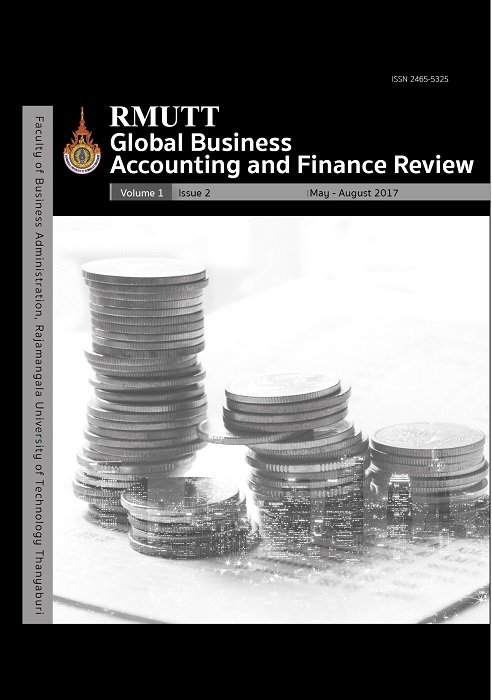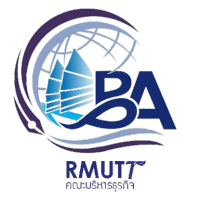Factors Affecting Consumer Behavior of Fast Food in Pathum Thani
คำสำคัญ:
Fast food, Consumer behavior, Marketing mixบทคัดย่อ
The purpose of this research was to study factors affecting consumer behavior of fast food. There were 200 samples chosen from people who lived in Pathum Thani by convenient sampling method. The data were statistically analyzed by using descriptive statistics comprising frequency, percentage, mean, and standard deviation and inferential statistics including Independent Samples t-test, One-Way ANOVA, Chi-square, and Correlation.
The results revealed that the majority of respondents were female, had age range more than 35 years old, and earned a bachelor’s degree. The most popular fast food brand of respondents was KFC. In addition, most of respondents normally bought in store, and the reason to buy was convenience. The results of hypothesis testing between demographics and consumer behavior revealed that gender, age, education, occupation, and income were associated with reason to buy fast food. Occupation and income were associated with brand preference while education and occupation were associated with channel to order fast food. Besides, age and occupation caused differences in frequency per month and budget per time. The results of hypothesis testing between the marketing mix and consumer behavior showed that product and place affected reason to buy while place and promotion affected brand preference at a significance level of 0.05.
เอกสารอ้างอิง
Allahar, H. (2015). Consumer behavior and the growth of the fast food industry in a small emerging country. International Journal of Advances in Management and Economics, 4, 180-189.
Aruppillai, T. and Godwin Phillip, P. M. (2015). An analysis of consumers’ buying behavoiur and its determinants of fast food in Sri Lanka. International Journal of Economics and Finance, 7(9), 112-119.
Asamoah, E. S. and Chovancová, M. (2011). The theory of consumer behaviour in fast food marketing: Strategies for competitive advantage. Recent Researches in Economics, 51-56.
Blackwell, R. D., Miniard, P. W., and Engel, J. F. (2001). Consumer behavior (9th ed.). Fort Worth, TX: Harcourt College Publishers.
Dave, J. M., An, L. C., Jeffery, R. W., and Ahluwalia, J. S. (2009). Relationship of attitudes toward fast food and frequency of fast-food intake in adults. Obesity, 17, 1164–1170.
Deivanai, P. (2016). Factors influencing to preference of fast food restaurants. IOSR Journal of Business and Management (IOSR-JBM), 18(8), 20-25.
Howard, J. A. and Sheth, J. (1969). The theory of buyer behavior. New York: John Wiley and Sons.
Islam, N. and Ullah, G. M. (2010). Factors affecting consumers’ preferences on fast food items in Bangladesh. The Journal of Applied Business Research, 26(4), 131.
Kardes, F. R., Cronley, M. L., and Cline, T. W. (2008). Consumer behavior. Cincinnati, OH: South-Western College.
Kotler, P. and Keller, K. L. (2012). Marketing management. Upper Saddle River, NJ: Pearson Prentice Hall.
Kotler, P., Armstrong, G., Wong, V., and Saunders, J. (1999). Principles of marketing. Harlow: Pearson.
Kuester, S. (2012). MKT 301: Strategic Marketing & Marketing in Specific Industry Contexts. University of Mannheim.
McNeil, R. (2014, May 30). Research result. Thai children eat for relaxation. National News Bereau of Thailand. Retrieved from http://thainews.prd.go.th/centerweb/newsen/NewsDetail?NT01_NewsID=WNSOC5705300010010
Ministry of Commerce, Thailand. (2015). Retrieved from www.moc.go.th/index.php/moc-english.html
Nguyen, The Ninh & Phan, Hoai & Anh Vu, Phuong. (2015). The impact of marketing mix elements on food buying behavior: A study of supermarket consumers in Vietnam. International Journal of Business and Management, 10(10), 206-215.
Nondzor, H. E. and Tawiah, Y. S. (2015). Consumer perception and preference of fast food: A Study of tertiary students in Ghana. Science Journal of Business and Management, 3(1), 43-49.
Office of the National Economic and Social Development Board. (2016). NESDB ECONOMIC REPORT Thai Economic Performance in Q2 and Outlook for 2016. Retrieved from http://www.nesdb.go.th/nesdb_en/article_attach/article_file_20160815110939.pdf
Shaharudin, M. R., Mansor, S. W., and Elias, S. J. Food quality attributes among Malaysia’s fast food customer. International Business and Management, 2(1), 198-208.
Stone, M. and Desmond, J. (2007). Fundamentals of marketing (1st ed.). Oxford: Routledge.
Thailand Board of Investment. (2016). Thailand Investment Review: Thailand Gears Up to become the World’s Food Innovation Hub, July 2016 vol. 26 no.7. Retrieved from http://www.boi.go.th/upload/content/TIR_JULY_82855.pdf
USDA Foreign Agricultural Service. (2016). Global Agriculture Information Network: Thailand Food Service - Hotel Restaurant Institutional 2016. Retrieved from https://gain.fas.usda.gov/Recent%20GAIN%20Publications/Food%20Service%20-%20Hotel%20Restaurant%20Institutional_Bangkok_Thailand_12-29-2016.pdf.









